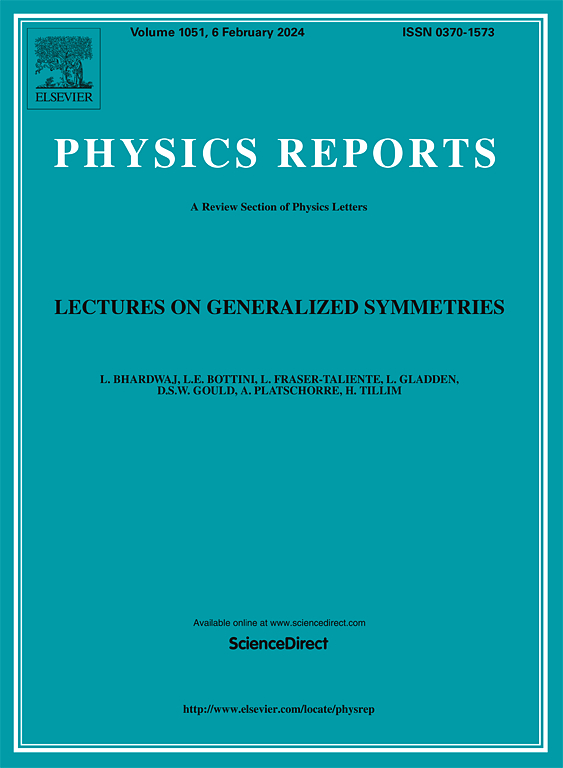Review: Quantum metrology and sensing with many-body systems
IF 29.5
1区 物理与天体物理
Q1 PHYSICS, MULTIDISCIPLINARY
引用次数: 0
Abstract
Quantum systems, fabricated across various spatial scales from nano to micrometers, are very delicate and naturally sensitive to the variations of their environment. These features make them excellent candidates for serving as sensors with wide range of applications. Indeed, the exceptional precision of quantum sensors arises from their compact size and inherent sensitivity, enabling measurements with unprecedented accuracy within highly localized regions. A key advantage of quantum sensors lies in their resource efficiency, as their achievable precision can scale super-linearly with respect to resources, such as system size, in contrast to the linear scaling characteristic of classical sensors. This phenomenon, commonly referred to as quantum-enhanced sensitivity, fundamentally depends on exploiting uniquely quantum mechanical features, including superposition, entanglement, and squeezing. Originally, quantum sensing was formulated for particles prepared in a special form of entangled states. Yet, certain realization of these probes may be susceptible to decoherence and interaction between particles may also be detrimental to their performance. An alternative framework for quantum sensing has been developed through exploiting quantum many-body systems, where the interaction between particles plays a crucial role. In this review, we investigate different aspects of the latter approach for quantum metrology and sensing. Many-body probes have been used for sensing purposes in both equilibrium and non-equilibrium scenarios. Quantum criticality, as a well-studied subject in many-body physics, has been identified as a resource for achieving quantum-enhanced sensitivity in both of these scenarios. In equilibrium, various types of criticalities, such as first order, second order, topological, and localization phase transitions have been exploited for sensing purposes. In non-equilibrium scenarios, quantum-enhanced sensitivity has been discovered for Floquet, dissipative, and time crystal phase transitions. While each type of these criticalities, either in equilibrium or non-equilibrium scenarios, has its own characteristics, the presence of one feature is crucial for achieving quantum-enhanced sensitivity and that is energy/quasi-energy gap closing. In non-equilibrium quantum sensing, time becomes another parameter which can affect the sensitivity of the probe. Typically, the sensitivity enhances as the probe evolves in time. In this review, we provide an overview on recent progresses on different aspects of quantum metrology and sensing with many-body systems.
综述:多体系统的量子计量与传感
量子系统跨越从纳米到微米的各种空间尺度,非常微妙,对环境的变化自然敏感。这些特性使它们成为具有广泛应用的传感器的优秀候选者。事实上,量子传感器的卓越精度源于其紧凑的尺寸和固有的灵敏度,能够在高度局部化的区域内以前所未有的精度进行测量。量子传感器的一个关键优势在于它们的资源效率,因为与经典传感器的线性缩放特性相比,它们的可实现精度可以相对于资源(如系统大小)进行超线性缩放。这种现象,通常被称为量子增强灵敏度,从根本上依赖于利用独特的量子力学特征,包括叠加、纠缠和挤压。最初,量子传感是为以特殊形式的纠缠态制备的粒子而制定的。然而,这些探针的某些实现可能容易退相干和粒子之间的相互作用也可能对它们的性能有害。利用量子多体系统开发了另一种量子传感框架,其中粒子之间的相互作用起着至关重要的作用。在这篇综述中,我们研究了量子计量和传感的后一种方法的不同方面。多体探针在平衡和非平衡两种情况下都被用于传感目的。量子临界性,作为多体物理学中一个被充分研究的主题,已经被确定为在这两种情况下实现量子增强灵敏度的资源。在平衡中,各种类型的临界,如一阶、二阶、拓扑和局部化相变已被用于传感目的。在非平衡状态下,发现了Floquet、耗散和时间晶体相变的量子增强灵敏度。虽然每种类型的临界,无论是在平衡还是非平衡情况下,都有自己的特征,但有一个特征的存在对于实现量子增强的灵敏度至关重要,那就是能量/准能隙的闭合。在非平衡态量子传感中,时间成为影响探针灵敏度的另一个参数。通常情况下,灵敏度随着探针时间的变化而增强。本文综述了近年来在多体系统量子计量和传感方面的研究进展。
本文章由计算机程序翻译,如有差异,请以英文原文为准。
求助全文
约1分钟内获得全文
求助全文
来源期刊

Physics Reports
物理-物理:综合
CiteScore
56.10
自引率
0.70%
发文量
102
审稿时长
9.1 weeks
期刊介绍:
Physics Reports keeps the active physicist up-to-date on developments in a wide range of topics by publishing timely reviews which are more extensive than just literature surveys but normally less than a full monograph. Each report deals with one specific subject and is generally published in a separate volume. These reviews are specialist in nature but contain enough introductory material to make the main points intelligible to a non-specialist. The reader will not only be able to distinguish important developments and trends in physics but will also find a sufficient number of references to the original literature.
 求助内容:
求助内容: 应助结果提醒方式:
应助结果提醒方式:


